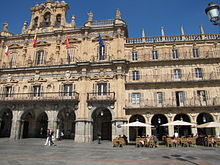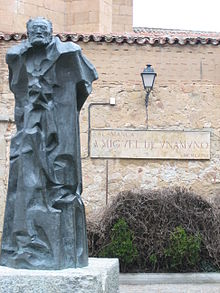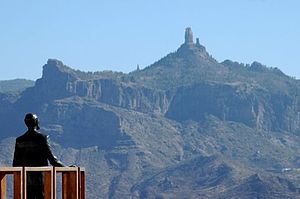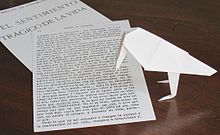- Miguel de Unamuno
-
 Miguel de Unamuno
Miguel de Unamuno
Miguel de Unamuno y Jugo (29 September 1864, Bilbao, Biscay, Basque Country, Spain – 31 December 1936, Salamanca, Salamanca, Castile and León, Spain) was a Spanish essayist, novelist, poet, playwright and philosopher.
Contents
Biography
Unamuno was often in the terrace of the Café Novelty, founded in 1905, in the Plaza Mayor of Salamanca.
Miguel de Unamuno was born in Bilbao, a port city of Spain, the son of Félix de Unamuno and Salomé Jugo. As a young man, he was interested in the Basque language, and competed for a teaching position in the Instituto de Bilbao, against Sabino Arana. The contest was finally won by the Basque scholar Resurrección María de Azkue.
Unamuno worked in all major genres: the essay, the novel, poetry and theatre, and, as a modernist, contributed greatly to dissolving the boundaries between genres. There is some debate as to whether Unamuno was in fact a member of the Generation of '98 (an ex post facto literary group of Spanish intellectuals and philosophers that was the creation of José Martínez Ruiz — a group that includes Antonio Machado, Azorín, Pío Baroja, Ramón del Valle-Inclán, Ramiro de Maeztu and Ángel Ganivet, among others).
In addition to his writing, Unamuno played an important role in the intellectual life of Spain. He served as rector of the University of Salamanca for two periods: from 1900 to 1924 and 1930 to 1936, during a time of great social and political upheaval. Unamuno was removed from his two university chairs by the dictator General Miguel Primo de Rivera in 1924, over the protest of other Spanish intellectuals. He lived in exile until 1930, first banished to Fuerteventura (Canary Islands), from where he escaped to France. After a year in Paris, Unamuno established himself in Hendaye in the French Basque Country, on the border with Spain. Unamuno returned to Spain after the fall of General Primo de Rivera's dictatorship in 1930 and took up his rectorship again. It is said in Salamanca that the day he returned to the University, Unamuno began his lecture by saying "As we were saying yesterday, ...", as Fray Luis de León had done in the same place four centuries before, as though he had not been absent at all. After the fall of Rivera's dictatorship, Spain embarked on its second Republic. He was a candidate for the small intellectual party Agrupación al Servicio de la República.
Having begun his literary career as an internationalist, Unamuno gradually became convinced of the universal values of Spanish culture, feeling that Spain's essential qualities would be destroyed if influenced too much by outside forces. Thus he welcomed Franco's revolt as necessary to rescue Spain from the excesses of the Spanish Republic.[citation needed] However, the harsh tactics employed by the Francoists in the struggle against their republican opponents caused him to oppose both the Republic and Franco. Unamuno said of the military revolt that it would be the victory of "a brand of Catholicism that is not Christian and of a paranoid militarism bred in the colonial campaigns", referring in the latter case to uprising of Franco's forces in Spanish Morocco.[1]
In 1936 Unamuno had a public quarrel with the Nationalist general Millán Astray at the University in which he denounced both Astray—with whom he had had verbal battles in the 1920's—and elements of the rebel movement. He called the battle cry of the elite armed forces group named La Legión—"Long live death!"—repellent and suggested Astray wanted to see Spain crippled. One historian notes that his address was a "remarkable act of moral courage" and that he risked being lynched on the spot but was saved by Franco's wife who took him out of the place. Shortly afterwards, Unamuno was effectively removed for a second time from his University post, broken-hearted. His death followed ten weeks later.[2]
Unamuno was a well-known lusophile, being probably the best Spanish connoisseur of Portuguese culture, literature and history of his time. He believed it was as important for a Spaniard to became familiar with the great names of Portuguese literature as with those of Catalan literature. He was also a supporter of Iberian Federalism.
Fiction
Unamuno wrote the following books, in chronological order:
- Paz en la guerra (Peace in War) (1897) — a novel that explores the relationship of self and world through familiarity with death. It is based on his experiences as a child during the Carlist siege of Bilbao in the Third Carlist War.
- Amor y pedagogía (Love and Pedagogy) (1902) — a novel uniting comedy and tragedy in an absurd parody of positivist sociology.
- El espejo de la muerte (The Mirror of Death) (1913) — a collection of stories.
- Niebla (Mist) (1914) — one of Unamuno's key works, which he called a nivola to distinguish it from the supposedly fixed form of the novel ("novela" in Spanish).
- Abel Sánchez (1917) — a novel that uses the story of Cain and Abel to explore envy.
- Tulio Montalbán (1920) — a short novel on the threat of a man's public image undoing his true personality, a problem familiar to the famous Unamuno.
- Tres novelas ejemplares y un prólogo (Three Exemplary Novels and a Prologue) (1920) — a much-studied work with a famous prologue. The title deliberately recalls the famous novelas ejemplares of Miguel de Cervantes.
- La tía Tula (Aunt Tula) (1921) — his final large-scale novel, a work about maternity, a theme that he had already examined in Amor y pedagogía and Dos madres.
- Teresa (1924) — a narrative work that contains romantic poetry, achieving an ideal through the re-creation of the beloved.
- Cómo se hace una novela (How to Make a Novel) (1927) — the autopsy of an Unamuno novel.
- Don Sandalio, jugador de ajedrez (Don Sandalio, Chess Player) (1930).
- San Manuel Bueno, mártir (Saint Emmanuel the Good, Martyr) (1930) — a brief novella that synthesizes virtually all of Unamuno's thought. The novella centres on a heroic priest who has lost his faith in immortality, yet says nothing of his doubts to his parishioners, not wanting to disturb their faith, which he recognizes is a necessary support for their lives.
Philosophy
Unamuno's philosophy was not systematic, but rather a negation of all systems and an affirmation of faith "in itself." He developed intellectually under the influence of rationalism and positivism, but during his youth he wrote articles that clearly show his sympathy for socialism and his great concern for the situation in which he found Spain at the time. An important concept for Unamuno was intrahistoria. He thought that history could best be understood by looking at the small histories of anonymous people, rather than by focusing on major events such as wars and political pacts.
Unamuno's Del Sentimiento Trágico de la Vida (The Tragic Sense of Life) (1912) as well as two other works — La Agonía del Cristianismo (The Agony of Christianity) (1931) and his novella "San Manuel Bueno, mártir" — were included on the Index Librorum Prohibitorum.
Unamuno summarized his personal creed thus: "My religion is to seek for truth in life and for life in truth, even knowing that I shall not find them while I live." [3] He said, "Among men of flesh and bone there have been typical examples of those who possess this tragic sense of life. I recall now Marcus Aurelius, St. Augustine, Pascal, Rousseau, Rene, Obermann, Thomson, Leopardi, Vigny, Lenau, Kleist, Amiel, Quental, Kierkegaard--men burdened with wisdom rather than with knowledge."[4] He provides a stimulating discussion of the differences between faith and reason in his book The Tragic Sense of Life.
A historically influential paperfolder, from childhood to his last, difficult days, in several works Unamuno ironically expressed philosophical views of Platonism, Scholasticism, positivism, and the "science vs religion" issue in terms of 'origami' figures, notably the traditional Spanish pajarita.[5]
Poetry
For Unamuno, art was a way of expressing spiritual problems. His themes were the same in his poetry as in his other fiction: spiritual anguish, the pain provoked by the silence of God, time and death.
Unamuno was always attracted to traditional meters and, though his early poems did not rhyme, he subsequently turned to rhyme in his later works.
Among his outstanding works of poetry are:
- Poesías (Poems) (1907) — his first collection of poetry, in which he outlined the themes that would dominate his poetics: religious conflict, Spain, and domestic life
- Rosario de sonetos líricos (Rosary of Lyric Sonnets) (1911)
- El Cristo de Velázquez (The Christ of Velázquez) (1920) — a religious work, divided into four parts, where Unamuno analyzes the figure of Christ from different perspectives: as a symbol of sacrifice and redemption, as a reflection on his Biblical names (Christ the myth, Christ the man on the cross, Christ, God, Christ the Eucharist), as poetic meaning, as painted by Diego Velázquez, etc.
- Andanzas y visiones españolas (1922) — something of a travel book, in which Unamuno expresses profound emotion and experiments with landscape both evocative and realistic (a theme typical of his generation of writers)
- Rimas de dentro (Rhymes from Within) (1923)
- Rimas de un poeta desconocido (Rhymes from an Unknown Poet) (1924)
- De Fuerteventura a París (From Fuerteventura to Paris) (1925)
- Romancero del destierro (Ballads of Exile) (1928)
- Cancionero (Songbook) (1953, published posthumously)
Drama
Unamuno's dramatic production presents a philosophical progression.
Questions such as individual spirituality, faith as a "vital lie", and the problem of a double personality were at the center of La esfinge (The Sphinx) (1898), and La verdad (Truth), (1899).
In 1934, he wrote El hermano Juan o El mundo es teatro (Brother Juan or The World is a Theatre).
Unamuno's theatre is schematic; he did away with artifice and focused only on the conflicts and passions that affect the characters. This austerity was influenced by classical Greek theatre. What mattered to him was the presentation of the drama going on inside of the characters, because he understood the novel as a way of gaining knowledge about life.
By symbolizing passion and creating a theatre austere both in word and presentation, Unamuno's theatre opened the way for the renaissance of Spanish theatre undertaken by Ramón del Valle-Inclán, Azorín, and Federico García Lorca.
Confrontation with Millán-Astray
On 12 October 1936 the celebration of Columbus Day had brought together a politically diverse crowd at the University of Salamanca, including Enrique Pla y Deniel, the Archbishop of Salamanca, and Carmen Polo Martínez-Valdés, the wife of Franco, Falangist General José Millán Astray and Unamuno himself. According to the British historian Hugh Thomas in his magnum opus The Spanish Civil War (1961), the evening began with an impassioned speech by the Falangist writer José María Pemán. After this, Professor Francisco Maldonado decried Catalonia and the Basque Country as "cancers on the body of the nation," adding that "Fascism, the healer of Spain, will know how to exterminate them, cutting into the live flesh, like a determined surgeon free from false sentimentalism."
From somewhere in the auditorium, someone cried out the motto "¡Viva la Muerte!" As was his habit, Millán-Astray responded with "¡España!"; the crowd replied with "¡Una!" He repeated "¡España!"; the crowd then replied "¡Grande!" A third time, Millán-Astray shouted "¡España!"; the crowd responded "Libre!" This was a common Falangist cheer. Later, a group of uniformed Falangists entered, saluting the portrait of Franco that hung on the wall.
Unamuno, who was presiding over the meeting, rose up slowly and addressed the crowd: "You are waiting for my words. You know me well, and know I cannot remain silent for long. Sometimes, to remain silent is to lie, since silence can be interpreted as assent. I want to comment on the so-called speech of Professor Maldonado, who is with us here. I will ignore the personal offence to the Basques and Catalonians. I myself, as you know, was born in Bilbao. The Bishop," Unamuno gestured to the Archbishop of Salamanca, "whether you like it or not, is Catalan, born in Barcelona. But now I have heard this insensible and necrophilous oath, "¡Viva la Muerte!", and I, having spent my life writing paradoxes that have provoked the ire of those who do not understand what I have written, and being an expert in this matter, find this ridiculous paradox repellent. General Millán-Astray is an invalid. There is no need for us to say this with whispered tones. He is an invalid of war. So was Cervantes. But unfortunately, Spain today has too many invalids. And, if God does not help us, soon it will have very many more. It torments me to think that General Millán-Astray could dictate the norms of the psychology of the masses. An invalid, who lacks the spiritual greatness of Cervantes, hopes to find relief by adding to the number of invalids around him."
Millán-Astray responded: "¡Muera la inteligencia! ¡Viva la Muerte!" ("Death to intelligence! Long live death!"), provoking applause from the Falangists. Pemán, in an effort to calm the crowd, exclaimed "¡No! ¡Viva la inteligencia! ¡Mueran los malos intelectuales!" ("No! Long live intelligence! Death to the bad intellectuals!")
Unamuno continued: "This is the temple of intelligence, and I am its high priest. You are profaning its sacred domain. You will win [venceréis], because you have enough brute force. But you will not convince [pero no convenceréis]. In order to convince it is necessary to persuade, and to persuade you will need something that you lack: reason and right in the struggle. I see it is useless to ask you to think of Spain. I have spoken." Millán-Astray, controlling himself, shouted "Take the lady's arm!" Unamuno took Carmen Polo by the arm and left in her protection.
See also
References
- ^ Helen Graham (2005). The Spanish Civil War: A Very Short Introduction. Very Short Introductions. Oxford University Press. p. 68. ISBN 9780192803771.[1]
- ^ Antony, Beevor (2006). The Battle for Spain. London: Phoenix. pp. 111–113.
- ^ Miguel de Unamuno, "Mi religión." (1907) http://www.ensayistas.org/antologia/XXE/unamuno/
- ^ Tragic Sense Of Life, I The Man Of Flesh And Bone
- ^ For example, in Amor y Pedagogica (1902) and a letter to the Argentinian Caras y Caretas the same year. For a bird-figure folded by him in November 1936, see Vicente Palacios, Papirogami: Tradicional Arte del Papel Plegado (Barcelona: Miguel Salvatella, 1972), p. 122. The term "origami" for such works is recent, Unamuno's own being "cocotología".
External links
- Biography, images and curiosities of Unamuno
- Tragic Sense Of Life From The Internet Archive
- Concordances of Unamuno's Poetry
- Unamuno's Letters to Candamo by Jesus Blazquez
- "God is dreaming you": Narrative as Imitatio Dei in Miguel de Unamuno by Costica Bradatan
- Dios te está soñando La narración como Imitatio Dei en Miguel de Unamuno por Costica Bradatan
Categories:- Existentialists
- 1864 births
- 1936 deaths
- People from Bilbao
- 19th-century philosophers
- 20th-century philosophers
- Members of the Royal Spanish Academy
- Spanish people of the Spanish Civil War
- Spanish dramatists and playwrights
- Spanish essayists
- Spanish novelists
- Spanish philosophers
- Spanish poets
- Basque writers
- Spanish agnostics
- University of Salamanca faculty
- Complutense University of Madrid alumni
- Origami artists
- Former Roman Catholics
Wikimedia Foundation. 2010.




